
Click the name of a planet to learn more about its visibility in February 2021: Jupiter, Saturn, Mars, Venus, Mercury
Try Stellarium for a precise view of the planets from your location.
Want precise planet rise and set times? Click here for recommended almanacs
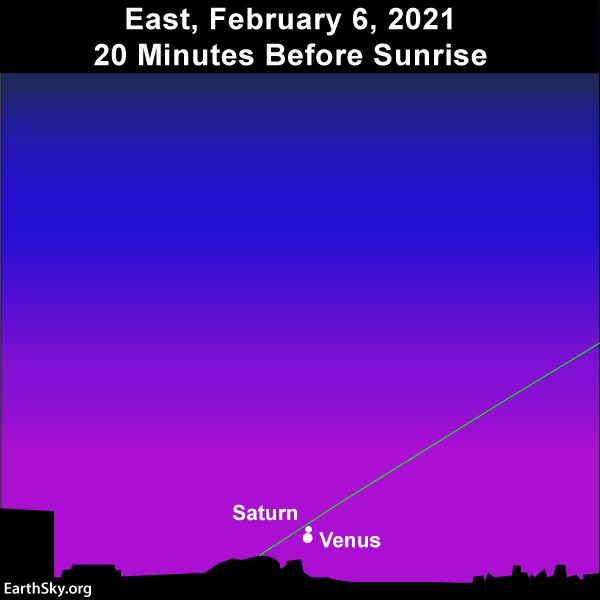
On February 6, 2021, the shallow tilt of the ecliptic will make the Venus-Saturn conjunction hard to spot from northerly latitudes, even with binoculars. This planetary conjunction is less obvious in the real sky than on our sky chart. Read more.
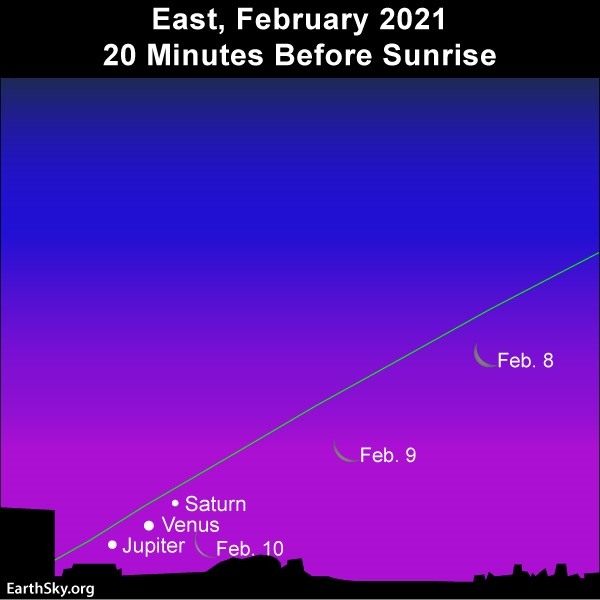
Venus, Jupiter and Saturn are officially in the morning sky, but we give you fair warning. They’re all considerably harder to see in the real sky than on this chart! They’ll be difficult to spot, even with binoculars. But planet-lovers might be comforted to know they’re there … and Jupiter and Saturn are soon to return to the predawn sky. Read more.
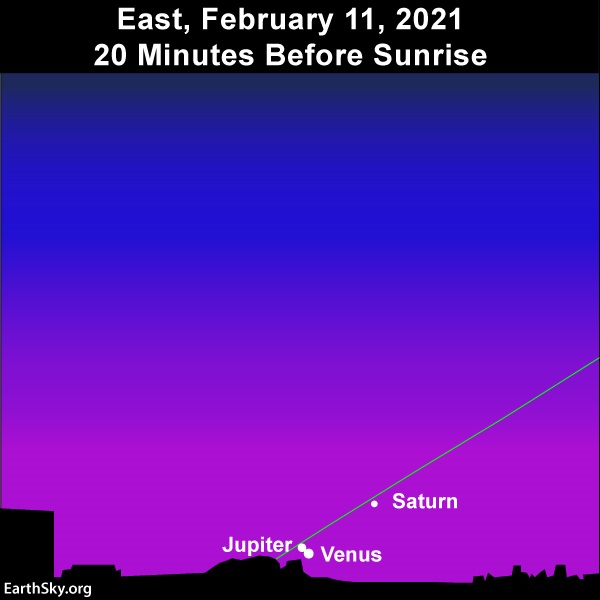
Venus and Jupiter will be in conjunction on February 11, 2021. Again, they’ll appear fainter in the real sky than on our sky chart. Bring binoculars and hope for a crystal-clear sky. Sigh. Read more.
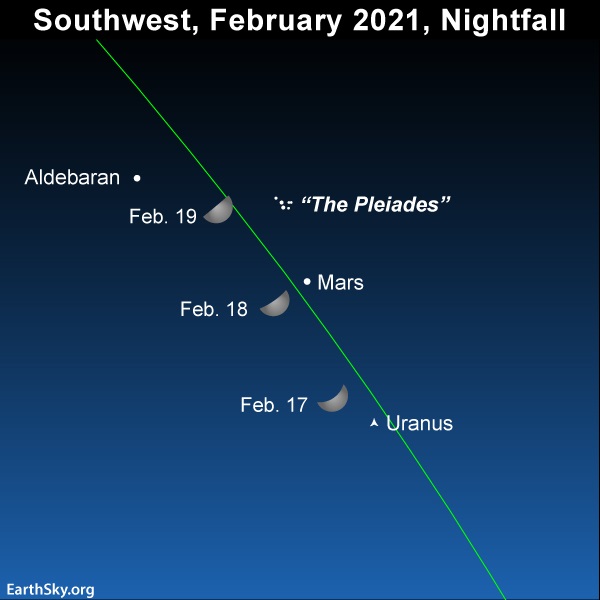
At last, something we can see! Let the moon serve as your guide to the red planet Mars on February 17, 18 and 19, 2021. Read more.
Mars is the only bright planet that’s out at nightfall and the evening hours throughout February 2021. Remember how bright Mars was in October 2020, when Earth passed between Mars and the sun? It was blazing then, and very red. Now it’s still reddish, but much duller, as Earth sweeps ahead in our smaller, faster orbit around the sun. Mars is highest up for the night at nightfall and slowly descends westward during the evening hours, finally setting in the west at or around midnight at mid-northern latitudes, and at mid-to-late evening at temperate latitudes in the Southern Hemisphere.
Modestly-bright Mars remains an easy object to see with the eye alone throughout February. Its ruddy starlike presence lights up our evening sky this month, especially since Mars is the only easy-to-see planet in this month’s sky! In the months ahead, the other planets will come back into view, and we’ll all forget about Mars, overlooking it as it slowly but surely dims and shifts toward the sunset. There will be a long period this year, some months from now, when Mars sits near the sunset, faint and inconspicuous before disappearing in earnest into the sun’s glare.
So enjoy Mars this month! Let the moon help guide your eye to the Red Planet for several nights centered on or near February 18, as shown on the chart above.
Read more: What to expect from Mars in 2021
Although you’d never know it just by looking, Jupiter and Saturn are fairly close together in the eastern dawn sky throughout February 2021. As the month begins, these two worlds are extremely hard to view in the glow of dawn, especially from northerly latitudes. We in this hemisphere can pretty much forget about them throughout the first half of February. But they’re there, and, day by day, the twosome are rising sooner before sunrise and appearing a bit higher in the sky at dawn. Jupiter will pop into view first, of course, because it’s brighter than Saturn. Start watching for these worlds later in February. For the best view, find an unobstructed horizon in the direction of sunrise. Seek them out with binoculars first. Toward the end of the month, try seeing them with the eye alone.
To find out when Jupiter and Saturn rise into your sky, consult either Old Farmer’s Almanac (USA and Canada) or TimeandDate (worldwide). Both of these worlds will be considerably easier to see in the morning sky by the month’s end.
By the way, Venus, the brightest of all planets, will start out the month above Jupiter and Saturn. But, even as January ended, Venus was already mostly hidden in the glare of morning twilight. And, as Jupiter and Saturn climb upward day by day, Venus will be sinking downward. Venus and Saturn will meet for a conjunction on February 6, and then Venus will rendezvous with Jupiter for a conjunction on February 11. After that, Venus will lurk beneath Jupiter and Saturn for rest of the month.
Throughout February, Saturn rises first and then Jupiter follows Saturn into the sky shortly thereafter. Below we give the rising time for Jupiter, the latter of these two planets to rise, at various latitudes (presuming a level horizon):
40 degrees north latitude
Early February: Jupiter and the sun rise at approximately the same time
Mid-February: Jupiter rises about 1/2 hour (30 minutes) before the sun
Early March: Jupiter rises about one hour (60 minutes) before the sun
Equator (0 degrees latitude)
Early February: Jupiter rises about 1/5 hour (12 minutes) before the sun
Mid-February: Jupiter rises about 3/4 hour (45 minutes) before the sun
Early March: Jupiter rises about 1 1/2 hours (90 minutes) before the sun
35 degrees south latitude
Early February: Jupiter rises about 1/4 hour (15 minutes) before the sun
Mid-February: Jupiter rises about one hour (60 minutes) before the sun
Early March: Jupiter rises about 2 hours (120 minutes) before the sun
Ready for a challenge? Have binoculars handy, and try your luck at spotting the furtive gathering of the waning crescent moon and the three morning planets (Saturn at top, Venus in between, and Jupiter at bottom) at dawn February 10, 2021! Then, one day later, try catching the Venus-Jupiter conjunction on February 11, and then, some 2 weeks later, watch the quasi-conjunction of Mercury and Saturn on February 23.
Venus – the brightest planet – reached its greatest elongation of 46 degrees from the sun in the morning sky on August 12 or 13, 2020 (depending upon your time zone). As February 2021 opens, however, there is little space between Venus and the rising sun. Venus’ angular distance from the sun – its distance from the sun on our sky’s dome – is about 18 degrees in early February and 9 degrees by the month’s end. Day by day, Venus sinks deeper and deeper into the morning twilight, and is especially difficult to view from northerly latitudes.
At mid-northern latitudes, Venus rises about 35 minutes before the sun in early February, tapering down to about 10 minutes by the month’s end.
At and near the equator, Venus rises 50 minutes before the sun in early February, decreasing to 20 minutes by the month’s end.
At temperate latitudes in the Southern Hemisphere, Venus rises 1 hour before the sun in early February, and around 40 minutes by the month’s end.
Why is Venus getting so close to the sunrise now, as seen from Earth? The answer is that Venus – in its smaller and faster orbit around the sun – is about to “turn the corner” ahead of us in orbit. In other words, Venus is about to pass on the far side of the sun from Earth. Its faster motion around the sun relative to Earth will eventually bring the sun between us and the sky’s brightest planet. Venus will exit the morning sky to enter the evening sky on March 26. It will be most nearly behind the sun, at superior conjunction as viewed from Earth, on March 26, 2021. It’ll return to the evening sky by late April or May, appearing near the western horizon as the bright evening “star.”
Throughout February 2021, Venus’ waxing gibbous phase will widen, yet its overall disk size will shrink, though the slight change won’t be all that noticeable through the telescope. Venus’ disk is 97% illuminated in early February, and over 99% illuminated at the month’s end; Venus’ angular diameter, on the other hand, will shrink to about 97% of its initial size by the end of February.
You may well need binoculars to see Venus pass 0.4 degrees south of Saturn on February 6.
Use the slender waning crescent moon to locate Venus – plus nearby Jupiter below Venus and nearby Saturn above Venus – on February 8, 9 and 10. Remember binoculars!
Last, but hardly least, watch for Venus to sweep 0.4 south of Jupiter for a planetary conjunction on February 11. Again, remember binoculars!
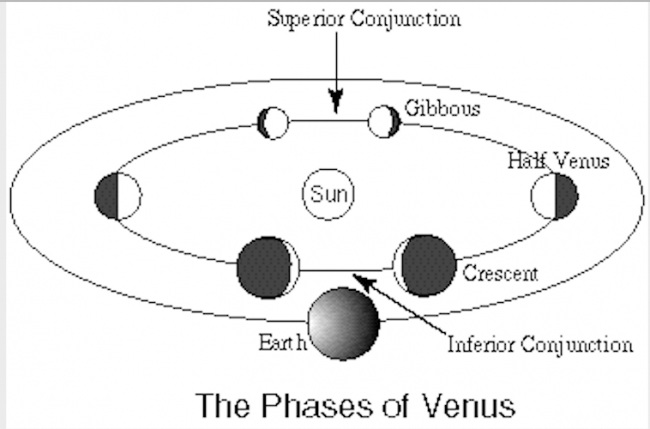
Inferior conjunction – when Venus sweeps between the sun and Earth – happened on June 3, 2020. Some 10 weeks later, Venus reached its greatest elongation in the morning sky on August 13, 2020 (when its disk was about 50% illuminated by sunshine). In February 2021, Venus will start the month about 97% illuminated and then end the month more than 99% illuminated. Image via UCLA.
Mercury is nominally an evening object during the first week of February, and a morning object during the last three weeks of February. Try catching Mercury is the last week of February and the first week of March an hour or so before sunrise. Your first good chance to spot Mercury may come when Mercury and Saturn stage a quasi-conjunction on February 23, 2021.
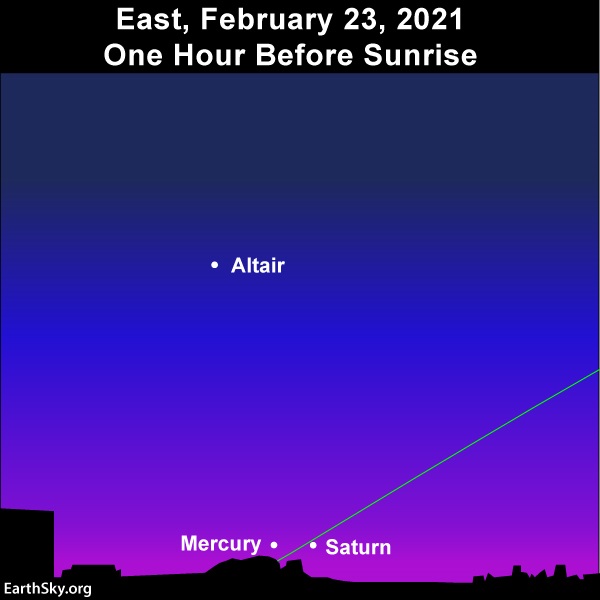
Your might first catch Mercury, the innermost planet, might come in the last week of February, when Mercury and Saturn pair up together at dawn. Read more.
What do we mean by bright planet? By bright planet, we mean any solar system planet that is easily visible without an optical aid and that has been watched by our ancestors since time immemorial. In their outward order from the sun, the five bright planets are Mercury, Venus, Mars, Jupiter and Saturn. These planets actually do appear bright in our sky. They are typically as bright as – or brighter than – the brightest stars. Plus, these relatively nearby worlds tend to shine with a steadier light than the distant, twinkling stars. You can spot them, and come to know them as faithful friends, if you try.
Bottom line: February presents a tough month for the planets! Mars is the only bright planet to be out at nighttime, during the evening hours! Venus, Jupiter and Saturn hide in the glow of morning dawn, with Mercury joining these furtive worlds in the second half of February.
Don’t miss anything. Subscribe to EarthSky News by email
Visit EarthSky’s Best Places to Stargaze to find a dark-sky location near you.
Help EarthSky keep going! Donate now.
Post your planet photos at EarthSky Community Photos.
from EarthSky https://ift.tt/1YD00CF

Click the name of a planet to learn more about its visibility in February 2021: Jupiter, Saturn, Mars, Venus, Mercury
Try Stellarium for a precise view of the planets from your location.
Want precise planet rise and set times? Click here for recommended almanacs

On February 6, 2021, the shallow tilt of the ecliptic will make the Venus-Saturn conjunction hard to spot from northerly latitudes, even with binoculars. This planetary conjunction is less obvious in the real sky than on our sky chart. Read more.

Venus, Jupiter and Saturn are officially in the morning sky, but we give you fair warning. They’re all considerably harder to see in the real sky than on this chart! They’ll be difficult to spot, even with binoculars. But planet-lovers might be comforted to know they’re there … and Jupiter and Saturn are soon to return to the predawn sky. Read more.

Venus and Jupiter will be in conjunction on February 11, 2021. Again, they’ll appear fainter in the real sky than on our sky chart. Bring binoculars and hope for a crystal-clear sky. Sigh. Read more.

At last, something we can see! Let the moon serve as your guide to the red planet Mars on February 17, 18 and 19, 2021. Read more.
Mars is the only bright planet that’s out at nightfall and the evening hours throughout February 2021. Remember how bright Mars was in October 2020, when Earth passed between Mars and the sun? It was blazing then, and very red. Now it’s still reddish, but much duller, as Earth sweeps ahead in our smaller, faster orbit around the sun. Mars is highest up for the night at nightfall and slowly descends westward during the evening hours, finally setting in the west at or around midnight at mid-northern latitudes, and at mid-to-late evening at temperate latitudes in the Southern Hemisphere.
Modestly-bright Mars remains an easy object to see with the eye alone throughout February. Its ruddy starlike presence lights up our evening sky this month, especially since Mars is the only easy-to-see planet in this month’s sky! In the months ahead, the other planets will come back into view, and we’ll all forget about Mars, overlooking it as it slowly but surely dims and shifts toward the sunset. There will be a long period this year, some months from now, when Mars sits near the sunset, faint and inconspicuous before disappearing in earnest into the sun’s glare.
So enjoy Mars this month! Let the moon help guide your eye to the Red Planet for several nights centered on or near February 18, as shown on the chart above.
Read more: What to expect from Mars in 2021
Although you’d never know it just by looking, Jupiter and Saturn are fairly close together in the eastern dawn sky throughout February 2021. As the month begins, these two worlds are extremely hard to view in the glow of dawn, especially from northerly latitudes. We in this hemisphere can pretty much forget about them throughout the first half of February. But they’re there, and, day by day, the twosome are rising sooner before sunrise and appearing a bit higher in the sky at dawn. Jupiter will pop into view first, of course, because it’s brighter than Saturn. Start watching for these worlds later in February. For the best view, find an unobstructed horizon in the direction of sunrise. Seek them out with binoculars first. Toward the end of the month, try seeing them with the eye alone.
To find out when Jupiter and Saturn rise into your sky, consult either Old Farmer’s Almanac (USA and Canada) or TimeandDate (worldwide). Both of these worlds will be considerably easier to see in the morning sky by the month’s end.
By the way, Venus, the brightest of all planets, will start out the month above Jupiter and Saturn. But, even as January ended, Venus was already mostly hidden in the glare of morning twilight. And, as Jupiter and Saturn climb upward day by day, Venus will be sinking downward. Venus and Saturn will meet for a conjunction on February 6, and then Venus will rendezvous with Jupiter for a conjunction on February 11. After that, Venus will lurk beneath Jupiter and Saturn for rest of the month.
Throughout February, Saturn rises first and then Jupiter follows Saturn into the sky shortly thereafter. Below we give the rising time for Jupiter, the latter of these two planets to rise, at various latitudes (presuming a level horizon):
40 degrees north latitude
Early February: Jupiter and the sun rise at approximately the same time
Mid-February: Jupiter rises about 1/2 hour (30 minutes) before the sun
Early March: Jupiter rises about one hour (60 minutes) before the sun
Equator (0 degrees latitude)
Early February: Jupiter rises about 1/5 hour (12 minutes) before the sun
Mid-February: Jupiter rises about 3/4 hour (45 minutes) before the sun
Early March: Jupiter rises about 1 1/2 hours (90 minutes) before the sun
35 degrees south latitude
Early February: Jupiter rises about 1/4 hour (15 minutes) before the sun
Mid-February: Jupiter rises about one hour (60 minutes) before the sun
Early March: Jupiter rises about 2 hours (120 minutes) before the sun
Ready for a challenge? Have binoculars handy, and try your luck at spotting the furtive gathering of the waning crescent moon and the three morning planets (Saturn at top, Venus in between, and Jupiter at bottom) at dawn February 10, 2021! Then, one day later, try catching the Venus-Jupiter conjunction on February 11, and then, some 2 weeks later, watch the quasi-conjunction of Mercury and Saturn on February 23.
Venus – the brightest planet – reached its greatest elongation of 46 degrees from the sun in the morning sky on August 12 or 13, 2020 (depending upon your time zone). As February 2021 opens, however, there is little space between Venus and the rising sun. Venus’ angular distance from the sun – its distance from the sun on our sky’s dome – is about 18 degrees in early February and 9 degrees by the month’s end. Day by day, Venus sinks deeper and deeper into the morning twilight, and is especially difficult to view from northerly latitudes.
At mid-northern latitudes, Venus rises about 35 minutes before the sun in early February, tapering down to about 10 minutes by the month’s end.
At and near the equator, Venus rises 50 minutes before the sun in early February, decreasing to 20 minutes by the month’s end.
At temperate latitudes in the Southern Hemisphere, Venus rises 1 hour before the sun in early February, and around 40 minutes by the month’s end.
Why is Venus getting so close to the sunrise now, as seen from Earth? The answer is that Venus – in its smaller and faster orbit around the sun – is about to “turn the corner” ahead of us in orbit. In other words, Venus is about to pass on the far side of the sun from Earth. Its faster motion around the sun relative to Earth will eventually bring the sun between us and the sky’s brightest planet. Venus will exit the morning sky to enter the evening sky on March 26. It will be most nearly behind the sun, at superior conjunction as viewed from Earth, on March 26, 2021. It’ll return to the evening sky by late April or May, appearing near the western horizon as the bright evening “star.”
Throughout February 2021, Venus’ waxing gibbous phase will widen, yet its overall disk size will shrink, though the slight change won’t be all that noticeable through the telescope. Venus’ disk is 97% illuminated in early February, and over 99% illuminated at the month’s end; Venus’ angular diameter, on the other hand, will shrink to about 97% of its initial size by the end of February.
You may well need binoculars to see Venus pass 0.4 degrees south of Saturn on February 6.
Use the slender waning crescent moon to locate Venus – plus nearby Jupiter below Venus and nearby Saturn above Venus – on February 8, 9 and 10. Remember binoculars!
Last, but hardly least, watch for Venus to sweep 0.4 south of Jupiter for a planetary conjunction on February 11. Again, remember binoculars!

Inferior conjunction – when Venus sweeps between the sun and Earth – happened on June 3, 2020. Some 10 weeks later, Venus reached its greatest elongation in the morning sky on August 13, 2020 (when its disk was about 50% illuminated by sunshine). In February 2021, Venus will start the month about 97% illuminated and then end the month more than 99% illuminated. Image via UCLA.
Mercury is nominally an evening object during the first week of February, and a morning object during the last three weeks of February. Try catching Mercury is the last week of February and the first week of March an hour or so before sunrise. Your first good chance to spot Mercury may come when Mercury and Saturn stage a quasi-conjunction on February 23, 2021.

Your might first catch Mercury, the innermost planet, might come in the last week of February, when Mercury and Saturn pair up together at dawn. Read more.
What do we mean by bright planet? By bright planet, we mean any solar system planet that is easily visible without an optical aid and that has been watched by our ancestors since time immemorial. In their outward order from the sun, the five bright planets are Mercury, Venus, Mars, Jupiter and Saturn. These planets actually do appear bright in our sky. They are typically as bright as – or brighter than – the brightest stars. Plus, these relatively nearby worlds tend to shine with a steadier light than the distant, twinkling stars. You can spot them, and come to know them as faithful friends, if you try.
Bottom line: February presents a tough month for the planets! Mars is the only bright planet to be out at nighttime, during the evening hours! Venus, Jupiter and Saturn hide in the glow of morning dawn, with Mercury joining these furtive worlds in the second half of February.
Don’t miss anything. Subscribe to EarthSky News by email
Visit EarthSky’s Best Places to Stargaze to find a dark-sky location near you.
Help EarthSky keep going! Donate now.
Post your planet photos at EarthSky Community Photos.
from EarthSky https://ift.tt/1YD00CF


Aucun commentaire:
Enregistrer un commentaire